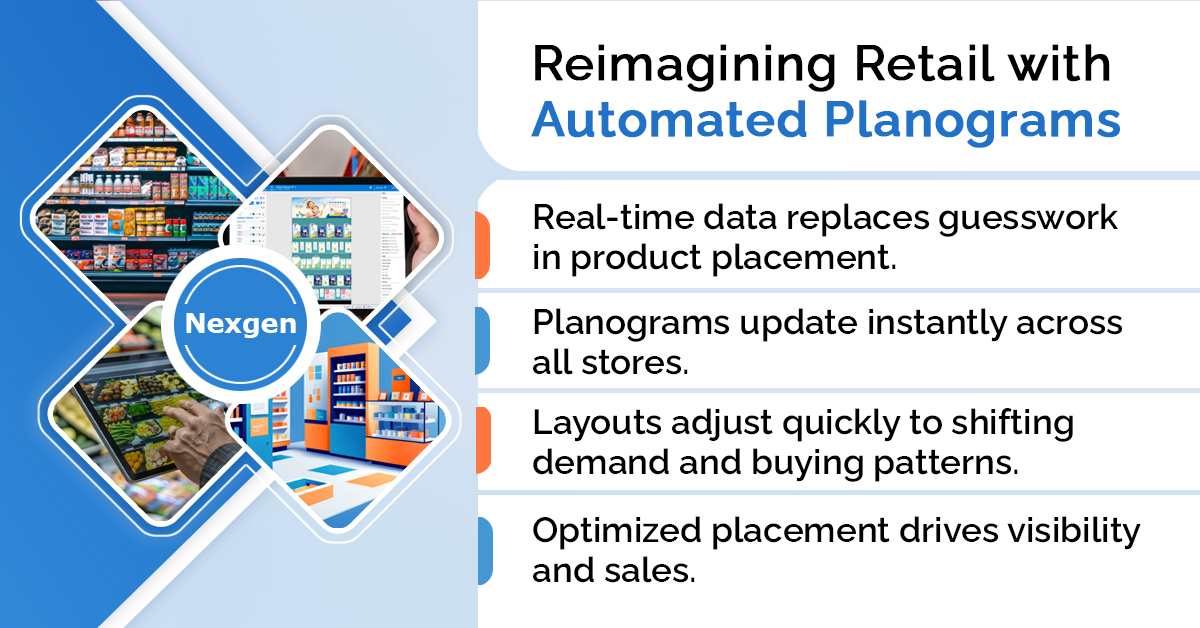Gone are the days when shelves were simply static displays, filled with products based on basic intuition and manual placement. Today, technology is transforming how retailers manage their shelf space, and one of the most groundbreaking innovations is the rise of automated planograms and dynamic shelves. From automating the process of creating planograms to implementing dynamic shelving that adapts to real-time data, automation is reshaping the retail landscape.
The Traditional Approach: Static Shelves and Manual Planning
Traditionally, retailers used static planograms — pre-designed layouts detailing where each product should be placed on a shelf. These layouts were often created manually or based on basic software tools, which were time-consuming and limited in their capacity to adjust to changing trends, seasons, or customer preferences. With static shelves, inventory placement remained unchanged unless manually adjusted by store employees. While this method was effective in its time, it had several key limitations:
- Inefficiency: Updating planograms required significant manual effort, which could result in errors and missed opportunities.
- Slow Response to Trends: Retailers could not quickly adapt to fast-moving consumer preferences or seasonal changes without making manual adjustments to shelf arrangements.
- Limited Data Utilization: Static displays did not incorporate real-time sales data or customer behavior insights, meaning many product placements were based on guesswork.
The Rise of Dynamic Shelves: What is Automation Bringing to the Table?
As technology has advanced, retail automation is changing how planograms are created and how shelf space is managed. Dynamic shelves are designed to adapt and optimize in real-time, responding to customer preferences, sales patterns, and stock levels automatically. Key innovations include:
1. Automated planogram creation.
Automation allows retailers to design and implement planograms quickly, adjusting layouts based on various factors such as seasonality, promotions, and customer buying behavior. Through data-driven insights, automated planogram tools can create optimal shelf layouts that not only look appealing but also drive higher sales. Following are some benefits:
- Faster time to market: Automation reduces the time needed to plan and implement a new layout. Retailers can launch new product displays or seasonal updates instantly.
- Accuracy: Automation minimizes human error and creates planograms that are aligned with real-time consumer data.
- Customization: Planograms can be tailored to specific store locations, regions, or even customer segments, ensuring the right products are placed in the right places.

2. Real-time shelf adjustments.
With the use of sensors, cameras, and machine learning, dynamic shelves can adjust in real-time based on stock levels and customer demand. For example, if a product is selling out faster than expected, the system can automatically adjust to display more of that product in prime shelf space. Similarly, if a particular item is underperforming, it can be moved or replaced with a better-performing alternative without human intervention.
- Maximized sales: By ensuring high-demand products are always visible and well-stocked, dynamic shelves can help retailers boost their sales.
- Reduced out-of-stock: Automation helps to ensure shelves are stocked according to customer needs, reducing the frequency of empty shelves and improving the overall customer experience.
- Optimized shelf space: Retailers can efficiently manage their shelf space by continuously optimizing product placement based on current sales data and customer behavior.
3. Incorporating customer behavior data.
Automated systems do not just rely on inventory data; they also leverage customer insights. Through facial recognition, foot traffic analysis, and purchase history, automation tools can understand how customers interact with specific products. This data can then be used to tailor product placement to maximize visibility and increase engagement.
- Personalization: Customers are presented with products they are more likely to purchase, leading to an improved shopping experience.
- Higher conversion rates: By placing products in the right spot at the right time, automation increases the chances of a sale, turning casual browsers into buyers.
- Targeted promotions: Retailers can also use dynamic shelving to highlight certain products based on customer demographics or behavior patterns, driving targeted promotions and personalized offers.
Overview of Nexgen Planogram Services
Nexgen offers store-specific planograms for clients that optimize sales and achieve category objectives. We create customized planograms for your business to ensure that these are better aligned with your goals and merchandising strategies. Our expertise in planogram automation helps us build planograms faster, better, and consistently. Whether it is creating a planogram from scratch, or a typical reset, we have the knowledge, tools, and experience to get the job done for you.
Get Your Free Trial Now!